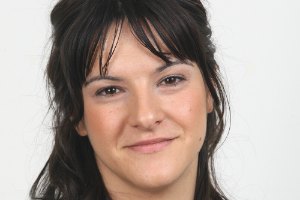Ten years in graphene - Dr Cinzia Casiraghi
11 Feb 2015
This is a blog by Dr Cinzia Casiraghi, a Reader in Graphene and Carbon Nanostructures at The University of Manchester. She is also the Chairperson of Graphene Week 2015 and was the recent recipient of the Marlow Award.

One day, back in September 2005 I received my first graphene sample. The box contained a small piece of silicon, which did not look anything exciting. The graphene flakes were tiny, about 10 micrometres in lateral size, and very difficult to see under the optical microscope - gold markers were needed to even identify the location of graphene on the substrate.
The last 10 years of graphene research have been characterised by immense technological progresses in production and fabrication of graphene-based devices. Today high-quality graphene can be grown on a much larger scale by chemical vapour deposition (CVD) and transferred to any substrate. Graphene inks can be easily produced and then used to make electrical and thermal conductive coatings by simple techniques such as drop-casting, spray coating or inkjet printing.
I have been working on graphene since its isolation in Manchester and contributed to its identification by Raman spectroscopy. A lot has changed since I first saw those tiny graphene flakes under the microscope and more possibilities are being uncovered daily.
Currently my group is investigating superlattices and heterostructures made of 2D crystals and thin films to develop new devices for flexible electronics. This family of 2D crystals allow the fabrication of devices based on complex vertical structures. Prototypes of touch screen panels, photovoltaics, OLED and tunnelling transistors, have already been fabricated.
This is an important year for The University of Manchester. In June we will host Graphene Week - a key international conference on this remarkable material. Graphene Week is the main annual event of the European Commission's biggest ever research initiative, the €1bn Graphene Flagship.
The conference will take place June 22-26 here at The University of Manchester and will see academics from all over the world gathering to discuss the fundamental science of graphene research and the applications of graphene based devices.
It is fascinating to see how fast the graphene field has grown and developed in just 10 years. In 2005 Graphene Week was a very small conference with less than 100 people attending and mainly focusing on fundamentals. In contrast, the last year’s conference in Gothenburg attracted 450 scientists from across the world, while more than 600 people are expected in Manchester this year. Topics now include applications of graphene in areas such as energy, sensors, health, composites, and talks by industrial speakers are also included in the programme.
I am delighted to be the Conference Chair of Graphene Week 2015, a position which means I have to ensure that a well-balanced and high quality scientific program will be presented. Assisted by the Programme and the Scientific Advisory committees, I am in charge of selecting the invited speakers, reviewing every submitted abstract and establishing the general format of the programme.
This amazing material never stops astonishing scientists and I do expect further intriguing results to be presented at Graphene Week 2015. Stay tuned for exciting news!
Dr Cinzia Casiraghi
Last call: deadline for Graphene Week 2015 abstract submissions – Sunday 15 February.
